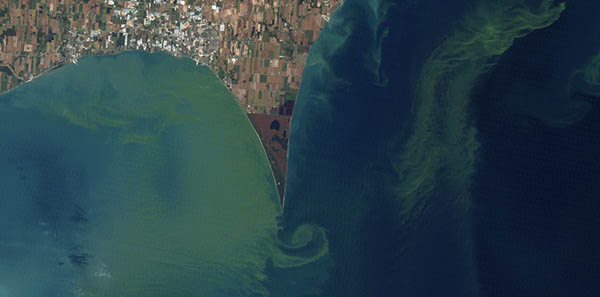- PRODUCTS
- MODEL LIST
- APPLICATIONS
- SUPPORT
- SALES/SERVICE
- BLOG
- ABOUT
Harmful Algal Blooms (HABs)

Among the thousands of species of microscopic algae at the base of the food chain, a few dozen produce toxins that impact people. These algae make their presence known during what is referred to as a "harmful algal bloom," or HAB. A HAB event may discolor the water, and are often called "red tides," but they frequently appear green, yellow, or brown, depending on the algae. Other species bloom in dilute, inconspicuous concentrations but are noticed because they produce potent toxins that kill marine organisms, or transfer through the food chain, harming organisms at multiple levels.
Harmful algal blooms (HABs) occur when conditions are conducive to exponential growth of one of these toxin producing algae, though reliable prediction can be difficult. Possible explanations range from natural mechanisms of species dispersal to anthropogenic actions such as nutrient loading, climatic shifts, or transport of algal species via ship ballast water.
HAB events now affect virtually every coastal area, an escalating and worrisome trend. Seafood industries such as fisheries and aquaculture face particular risks from HABs. As the impacts of mass mortalities of wild and farmed fish, marine mammals, seabirds, and illness and death in humans from contaminated fish or shellfish increase, research about the mechanisms of HAB events is urgently needed. See NOAA's National Ocean Service's site Harmful Algal Blooms: Tiny Organisms with a Toxic Punch for more extensive information.
Autonomous sensors can provide data for advance modeling and prediction of HABs.Sea-Bird Scientific builds absorption meters, scattering meters, and fluorometers that identify, characterize, and determine components of harmful algal blooms.
Which sensors help identify HABs?
Case Studies
- Case Study: Autonomous Systems Help To Understand Nutrient Sources Within The St. Lucie Estuary, Ian Walsh, December 2017
- Case Study: Measuring Nitrate in Puget Sound Using Optical Sensors, Sea-Bird Scientific, November 2017
- Case Study: High-Resolution Biophysical Observations in an Underway Sampling Application, Kim Martini, Sea-Bird Scientific, June 2017
- Case Study: Long-Term Water Quality Monitoring Deployments with the Sea-Bird Scientific HydroCAT-EP, Doug Wilson et al. May 2017

